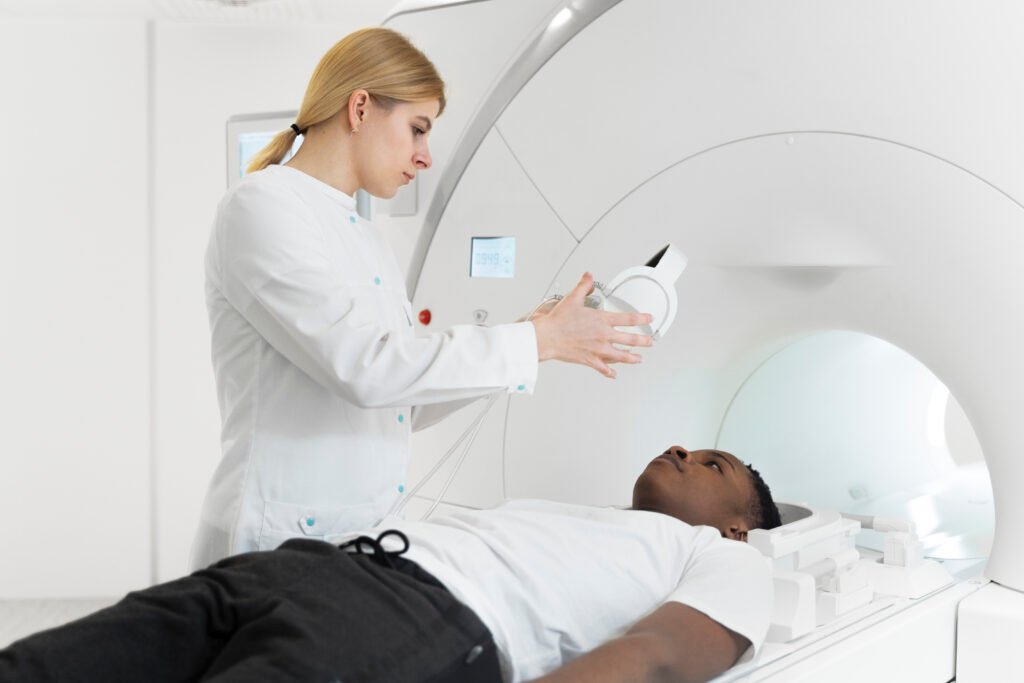Computed tomography angiography (CTA) has revolutionized vascular imaging. This non-invasive test uses advanced technology to take detailed pictures of blood vessels. Doctors use CTA scans to diagnose and manage heart diseases, including coronary artery disease. The scan helps identify blockages, aneurysms, and other life-threatening conditions. With the growing demand for accurate diagnostic reports, CTA reporting has become crucial. It guides treatment decisions and improves patient outcomes. A CTA scan is also known as a CT coronary scan or CT angiogram. It provides detailed images of vascular anatomy, enabling radiologists to make precise diagnoses.
This article will provide an overview of CT angiography, its applications, its benefits in modern medical imaging, and the importance of timely CT angio reporting.
What is CT Angiography?
CT Angiography, also known as a CT angiogram, is a medical test that uses X-rays and a special dye to take detailed pictures of blood vessels. It helps doctors see the inside of blood vessels and identify any blockages, aneurysms, or other problems. During the test, a dye is injected into a vein, and then X-rays are taken as the dye flows through the blood vessels. The resulting images provide a clear view of the blood vessels, allowing doctors to diagnose and treat various vascular conditions.
When is a CT Angiography Indicated?
A CT angiography, or CT angiogram, is often used to:
- Check for blocked or narrowed blood vessels: If you have symptoms like chest pain, shortness of breath, or leg pain, a CT angiogram can help doctors see if your blood vessels are blocked or narrowed.
- Diagnose aneurysms: An aneurysm is a bulge in a blood vessel that can burst and cause bleeding. A CT angiogram can help doctors find aneurysms in blood vessels.
- Plan for surgery: If you need surgery to fix a blood vessel problem, a CT angiogram can help doctors plan the best way to do the surgery.
- Check for blood vessel damage: If you’ve been injured, a CT angiogram can help doctors see if your blood vessels are damaged.
- Monitor blood vessel conditions: If you have a condition like atherosclerosis (hardening of the arteries), a CT angiogram can help doctors monitor how well your blood vessels are working.
How is CT Angio Reporting Done?
CT angio reporting involves the following steps:
Step 1: Pre-Reporting Preparation
- A CTA scan (also known as a CT angiogram or CT angiography) is performed to capture detailed images of blood vessels.
- The images are transferred to a computer system for analysis.
- The patient’s medical history and demographic information are gathered.
Step 2: Image Analysis
- A radiologist reviews the CTA images, analyzing the blood vessels for any blockages, aneurysms, or other abnormalities.
- Measurements are taken to assess the severity of any conditions found.
Step 3: Report Creation
- The radiologist documents their findings, including descriptions of blood vessel anatomy and any abnormalities.
- A diagnostic impression is formed, including a summary of key findings and recommendations for further evaluation or treatment.
- The report is finalized, ensuring accuracy and completeness.
What Are The Benefits of CT Angiography?
CT angiography (CTA) offers several benefits including:
Diagnostic Benefits
- Accurate diagnosis: CT angiography or angiogram helps diagnose vascular diseases, such as aneurysms, stenosis, and thrombosis, with high accuracy.
- Detailed imaging: CT angiography provides high-resolution images of blood vessels, allowing for precise evaluation of vascular anatomy and pathology.
- Non-invasive: CT angiography is a non-invasive procedure, reducing the risk of complications and discomfort associated with invasive angiography.
Therapeutic Benefits
- Guiding interventions: CT angiogram images help guide interventional procedures, such as angioplasty and stenting.
- Monitoring treatment: A CT angiogram can monitor the effectiveness of treatment and detect potential complications.
- Reducing surgical risks: CT angiograms can help identify patients who may not require surgery, reducing unnecessary surgical risks.
Patient Benefits
- Reduced recovery time: A CT angiogram is typically an outpatient procedure, allowing patients to return to their normal activities quickly.
- Less discomfort: CT angiography is generally less uncomfortable than invasive angiography.
Clinical Benefits
- Improved patient outcomes: CT angiograms can lead to better patient outcomes by enabling accurate diagnosis and guiding effective treatment.
- Enhanced clinical decision-making: CT angiography provides valuable information for clinicians to make informed decisions about patient care.
What is the Importance of Accurate And Timely CT Angio Reporting?
Accurate and timely reporting of CT angiogram results is crucial for effective patient care.
- A CT angiography (CTA) report provides vital information for diagnosing vascular diseases, guiding interventions, and monitoring treatment.
- Delays or errors in reporting can lead to misdiagnosis, inappropriate treatment, and adverse outcomes.
- In emergencies, timely CTA reporting can be lifesaving, particularly in cases of stroke or aortic dissection.
Conclusion
CT angiography is a vital diagnostic tool for visualizing vascular diseases, guiding interventions, and monitoring treatment outcomes. However, the accuracy and timeliness of CT angiogram reporting are equally crucial in ensuring optimal patient care. Delayed or inaccurate reporting can have serious consequences, including misdiagnosis, inappropriate treatment, and adverse outcomes. Vital Radiology ensures fast, precise, and reliable CT angiogram reporting, helping healthcare providers make informed decisions for better patient outcomes.












































